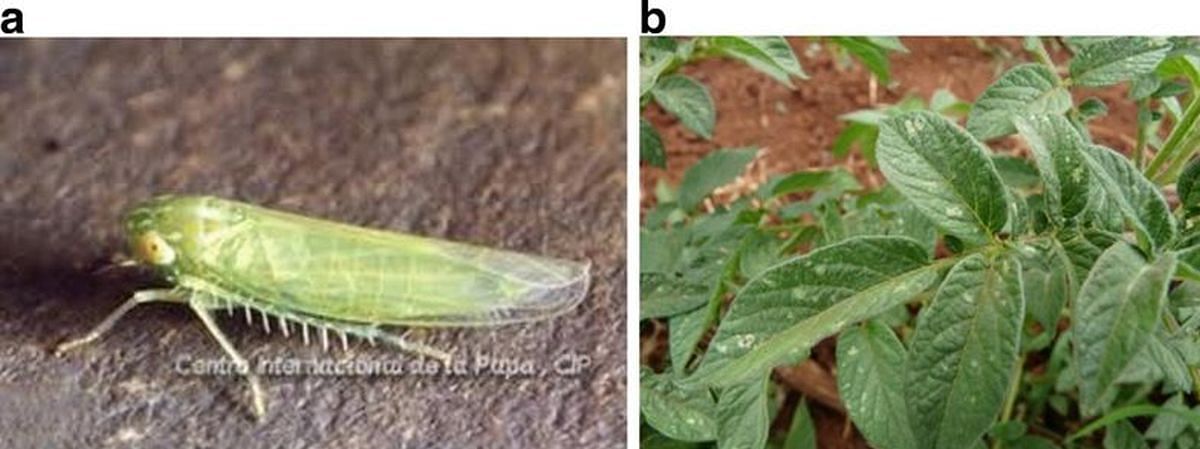Scientific description of the Potato Leafhoppers (2020)
The authors of this content are Jürgen Kroschel, Norma Mujica, Joshua Okonya, Andrei Alyokhin
Empoasca fabae (Harris 1841) (Hemiptera: Cicadellidae)
Distribution
The leafhopper Empoasca fabae is widely distributed (image below).
Distribution
The leafhopper Empoasca fabae is widely distributed (image below).

Empoasca fabae adult (a); and potato leave damage (b). (Courtesy: CIP)
Host range
E. fabae is a polyphagous pest. Its main hosts are potato, alfalfa, eggplant, bean, celery, cucumber, cucurbits, groundnut (Arachis hypogaea L.), melon, rhubarb (Rheum rhabarbarum L.), strawberry, sweet potato, and tomato.
E. fabae is a polyphagous pest. Its main hosts are potato, alfalfa, eggplant, bean, celery, cucumber, cucurbits, groundnut (Arachis hypogaea L.), melon, rhubarb (Rheum rhabarbarum L.), strawberry, sweet potato, and tomato.
Symptoms of infestation
The potato leafhopper E. fabae is a sucking insect that extracts sap directly from the vascular system of the leaflets, petioles and sometimes the stems. The attack on potato crops is sporadic and is favored by humid conditions. Insects live in the abaxial (lower) part of the leaflets.
They inject toxic saliva while feeding, causing leaf necrosis and interfering with plant growth. Under severe attack, the attacked plants die prematurely. Leafhopper can transmit some viruses, although their occurrence is rare (CIP 1996; Cook et al. 2004; Larrain et al. 2003).
The potato leafhopper E. fabae is a sucking insect that extracts sap directly from the vascular system of the leaflets, petioles and sometimes the stems. The attack on potato crops is sporadic and is favored by humid conditions. Insects live in the abaxial (lower) part of the leaflets.
They inject toxic saliva while feeding, causing leaf necrosis and interfering with plant growth. Under severe attack, the attacked plants die prematurely. Leafhopper can transmit some viruses, although their occurrence is rare (CIP 1996; Cook et al. 2004; Larrain et al. 2003).
Impacts on production losses
The complex of symptoms caused by the leafhopper leads to reduced growth and reproduction of plants. Depending on the stage of plant development, in heavily infested fields up to 75% the yield can be lost (Backus et al. 2005; Cook et al. 2004; Medeiros et al. 2004). E. fabae has become a major pest with the introduction of modern synthetic insecticides.
In Minnesota, USA, annual losses to potato were estimated at $US 7 million (Noetzel et al. 1985). The relationship between yield loss and leafhopper numbers have been determined to be directly linear (Radcliffe and Johnson 1994).
In south western Ontario, Canada, average losses of up to 85% for potatoes have been recorded (Tolman et al. 1986). E. fabae is also a serious pest of potato in some parts of India with severe hopper burn especially of early planted crops (Verma et al. 1994).
The complex of symptoms caused by the leafhopper leads to reduced growth and reproduction of plants. Depending on the stage of plant development, in heavily infested fields up to 75% the yield can be lost (Backus et al. 2005; Cook et al. 2004; Medeiros et al. 2004). E. fabae has become a major pest with the introduction of modern synthetic insecticides.
In Minnesota, USA, annual losses to potato were estimated at $US 7 million (Noetzel et al. 1985). The relationship between yield loss and leafhopper numbers have been determined to be directly linear (Radcliffe and Johnson 1994).
In south western Ontario, Canada, average losses of up to 85% for potatoes have been recorded (Tolman et al. 1986). E. fabae is also a serious pest of potato in some parts of India with severe hopper burn especially of early planted crops (Verma et al. 1994).
Methods of prevention and control
Most of the potato leafhopper management in potato and other crops is based on monitoring, cultural control, and the use of insecticides.
Most of the potato leafhopper management in potato and other crops is based on monitoring, cultural control, and the use of insecticides.
- Monitoring.
he presence of the leafhopper can be determined rapidly using entomological nets or yellow sticky traps located at the edges of the crop. Nymphs are best monitored by examining the leaves, especially the underside.
Monitoring middle part of a plant gives a more precise estimate of the population of leafhopper nymphs than monitoring basal and apical parts.
The economic threshold in potato is 10 or more nymphs per 100 leaves, or 10% of the leaves infested with nymphs (CIP 1996; Cook et al. 2004). - Cultural practices.
Infestation of potato fields may be prevented by avoiding proximity to crops such as beans that host high leafhopper populations. Also, elimination of crop residues and appropriate irrigation help reduce populations of this pest (Larrain et al. 2003). - Natural control.
Although the leafhopper has several natural enemies, such as predators and parasites, they play a very minor role in potato leafhopper control (CIP 1996; Cook et al. 2004; Larrain et al. 2003). - Plant resistance.
Resistant or tolerant varieties should be considered in affected regions, but if leafhopper populations increase, systemic insecticides may become necessary (Backus et al. 2005). - Chemical control.
Applications must be made only if populations reach economic thresholds.
